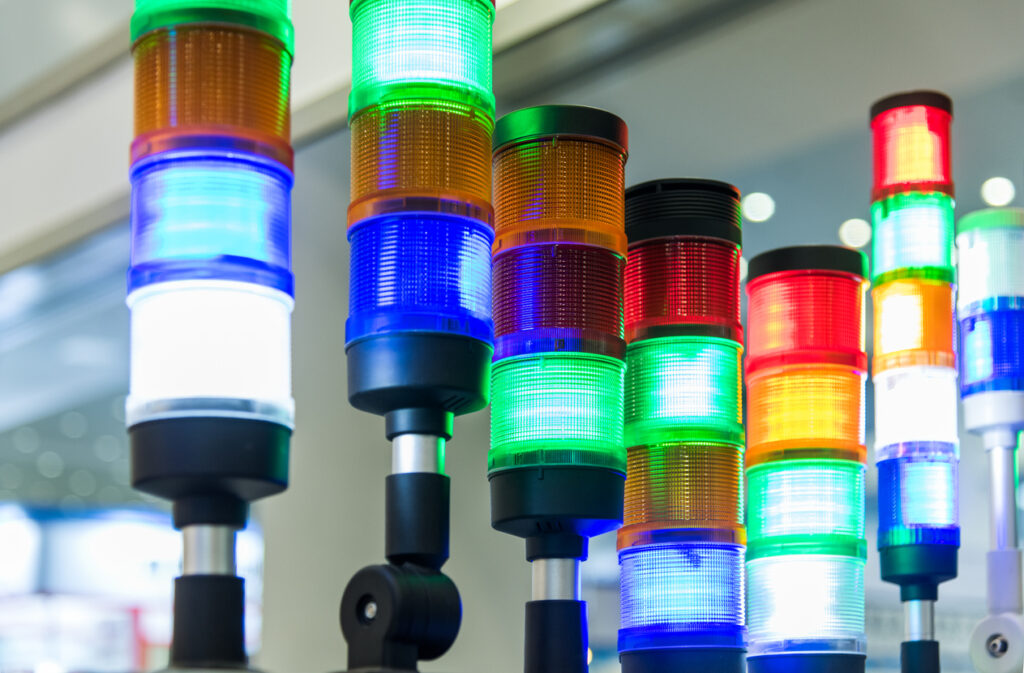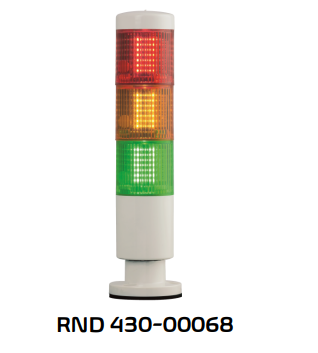Automation signalling is vital to efficient workflow and properly managed operations of machines. If you want to improve your workplace, automation signalling devices, such as beacons, horns and sirens will improve functionality of your industrial plant and help you ensure the safety of your personnel. Some signalling systems are obligatory in workplaces, such as warning buzzers or emergency lighting. With RND’s new range of automation signalling devices you can increase your facility performance and keep your workforce safe.
Introduction to signalling devices
Automation signalling devices are designed to alert operators to faults, enabling problems to be rectified quickly, avoiding long and costly production downtimes. Command and signalling devices allow for manual and automatic, local and remote control of loads and lines. They also provide a variety of functions, including acoustic signalling, remote control, visual status indication of machines and devices, circuit separation, and visual and acoustic signalling.
They are used in various applications, such as transportation, industrial facilities, and public spaces. Some examples of signalling devices include signal towers, sirens, buzzers, horns, and beacons.
Automation signalling and its law
National legislation clearly defines industrial signalling and its application. The usage of signalling components is required by law for both industrial machinery makers and users. When the safety and lives of those nearby are in danger or when equipment problems or flaws appear, these components must reliably transmit warning signals (audible or optical). They should also state whether the machinery is operational. The messages must be unambiguous and readily apparent.
In Europe, the Directive 2006/42/EC sets the rules for the use of signalling devices. However, the form of signalling might vary depending on the type of machinery and industry.
Types of signalling devices
The purpose of signalling devices is to send warnings, either visual or audible. For instance, signalling lights, which resemble traffic lights, are simple optical warning devices with a powerful light source, often an LED, halogen, or xenon lamp. They are suited for non-verbal information transmission and come in the colours red, yellow, orange, and green.

There are three main categories of signalling devices:
- Optical signalling devices
- Audible signalling devices
- Optical-audible signalling devices
Optical signalling devices
The two main optical signalling technologies that are most often utilised are lamps and signal columns (sometimes called signal towers or beacons). Optical signalling devices are used primarily to indicate the state and operation of plants, industrial machinery, and control cabinets. Hence, the applications of these devices are in the industrial sector as parts of industrial signalling systems (lights and columns) in manufacturing plants, but they can also be employed in logistics, transportation, sports, or public facilities, such as access control systems.
Audible signalling devices
Acoustic signalling devices, often known as audible signalling devices, alert people to an incident or potential threats. They have a loud signal tone that they can use in a variety of ways, such as a buzzer, siren, constant or irregular sound, or a bell.

When selecting an audible signalling device, you should take into account not only the volume of the sound that is produced and how it is signalled, but also – as with optical signalling devices – the IP rating, operating temperature, power supply voltage and electricity consumption.
Optical-audible signalling devices
The third category is optical-audible signalling devices, mostly employed in signalling systems, technical installations and specific applications, such as when the optical signal alone is insufficient or when double signalling is necessary. The audio indicator further highlights the functionality of the visual signalling system.
Two transducers (often piezoceramic) are included in optical-audible signalling devices, allowing for separate operation of the sound and visual signal.
Common signal devices – RND product selection
RND’s signalling range includes signal towers, signal modules, beacons, horns and other sounders. Most of them are based on LED technology which has become the global norm for signal lights. You can benefit from long-lasting equipment as LED signalling devices often don’t require any kind of electrical maintenance or other services. We have briefly described below some of the most common types of signal devices to help you choose the best one for your facility:
Signal Towers
Signal towers and stack lights are crucial visual instruments for managing intricate systems. They function as audio or visual warning systems during emergencies, for use in machines or during automation processes. The signal tower’s colour and condition is denoted by this directive. A buzzer is included in the standard signal towers and columns.

By using professional signalling systems, employees are better equipped to respond swiftly to errors and solve issues. This enhances security and shortens reaction and waiting times in the broadest range of application areas.
In RND’s offer there are LED signal towers which can enhance the safety of workers and equipment.
Signal Lights or Beacons
Signal lights, also known as beacons, similarly to signal towers, are visual signalling devices that use coloured lights to convey information. They typically consist of multiple stacked lights, each capable of emitting different colours to indicate specific conditions or status. The lights can rotate, flash or flash strobe, depending on the conditions.
A sounder beacon’s audio range will typically be 5 to 15 decibels louder than the surrounding noise level. There are several factors to take into account when determining a sounder beacon’s coverage area. It must be loud enough to be heard over background noise in the workplace and throughout all relevant areas of the building.

From RND you can purchase multi-functional LED signal beacons in blue, red and orange colours in different power voltages ranging from 12 V to 24 V and 120 V to 240 V.
Sirens & Horns
Signalling equipment is used to alarm locally. Internal and external alarms are distinguished from one another. When individuals are present in the building being monitored, internal alerting is employed. It is only used to alert individuals to a risk. Both visual signalling devices (strobe lights) and audio signalling devices (sirens and horns) are used for external alerting. To alert everyone in the workplace, neighbourhood or wider public external alerting is utilised.
RND has a wide array of audio signalling equipment to choose from, offering sounders with 105 dB and 24 to 123/230 VAC/VDC, electro-mechanical sirens and LED signal sirens in red, yellow and blue colours.

As well as sirens, RND’s range of automation signalling includes simple signal horns with 95 dB and horn signal beacons to give acoustic and luminous warnings.
Signal Modules
In addition to pre-built/configured signal towers, individual signal modules can be purchased separately and built to allow for a fully customised signal tower based on the users needs. Modules are available in both 24V or 240V variants, making it possible to configure a signal tower for a wide range of applications.
RND has sounder modules available with standard base (IP45 rated) or a deep base (IP65 rated), and LED light modules in a variety of luminous colours.

FAQs
First, before choosing a signal device you need to think about intended application and environmental conditions (e.g., indoor or outdoor, temperature, moisture), then focus on visibility or audibility requirements, compliance with industry standards or regulations, power source options, ease of installation and maintenance, and integration capabilities with existing systems.
We’ve highlighted some of its applications here. The most common ones are transportation (incl. airports, railways, roadways), manufacturing facilities, warehouses, public buildings, healthcare facilities, fire and security systems, marine application and construction sites.
Signalling devices can connect through various methods such as hardwiring, communication protocols (e.g., Modbus, Profibus), or wireless connectivity. Integration with control systems allows for centralised control, synchronisation, and coordinated signalling based on predefined conditions or events.
Yes, many signalling device manufacturers offer customisation options to meet specific requirements. Customisation may include colour choices, mounting options, audible signal patterns, message customisation for displays, and other features tailored to the application’s needs.
Signalling devices designed for outdoor or harsh environments are typically built to be durable and weatherproof. They are often constructed with materials that can withstand extreme temperatures, moisture, dust, vibrations, and other environmental factors.
Many modern signalling devices employ energy-efficient technologies such as LED lighting, which consumes less power compared to traditional incandescent bulbs. Energy-saving features like motion sensors or automatic dimming are also available in some devices to optimise energy usage.
Yes, there are industry-specific regulations and standards that govern the design, performance, and installation of signalling devices. Examples include the International Electrotechnical Commission (IEC) standards. Make sure you check the relevant standards in your country.










